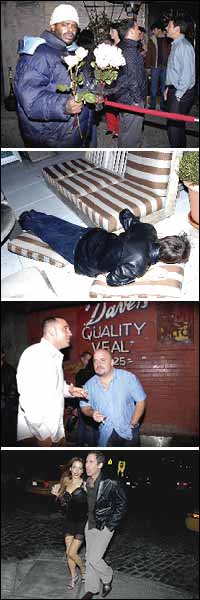
Coming home to the Village from a dinner party on the Upper West Side this past weekend shortly after midnight, I found myself skirting the meatpacking district, cruising east on Fourteenth. You could almost feel the shock wave rocking the Volvo as we crossed Ninth Avenue. A collective moan rose from my friends—an actor, a journalist, and a publishing exec—as we looked down the avenue, which was teeming and raucous with Saturday-night heat seekers, illuminated by the drossy fluorescence of the Hotel Gansevoort. The scene required no overt comment from our crowd, only grunts and expletives. “The new Date Rape Row,” someone finally said.
So—that didn’t take long. As I recall, it took Soho at least ten years to become a parody of itself, to move from bohemian fringe neighborhood to theme park, from buzzword to cliché, from Samo to Sam Waksal.
When I arrived in town twenty-odd years ago, I lived a few blocks from the district. By day, it was populated by rough men with outer-borough accents in bloody white aprons, carrying hacksaws and haunches of beef. At night, a different sort of worker ruled the sidewalks. It took me about a year to figure out why the gaudy Amazons tottering on high heels after dark were so damn tall and had such deep voices. I was quicker to understand what they meant when they asked if I wanted a date. Years later, when Keith McNally mentioned that he was thinking about opening a restaurant over there, a sidewalk-café kind of thing, I told him that I thought the smell might keep people away. That’s how sharp my business sense is.
Pastis was, of course, the beginning of the transformation; the opening of the Hotel Gansevoort—the physical equivalent of the Tour Montparnasse, another shiny blight on a low-rise neighborhood—was the tipping point. This is the inevitable cycle of trendification in the city, trend seekers following the trendsetters into a fringe area of the city. The only difference is that there wasn’t a real bohemian or artistic culture that was co-opted and displaced. (The meatpackers seem to have been gradually migrating across the river since the nineties.) The only surprise is the speed of the change, the rapidity with which we started to use italics to pronounce the name of the place that, ever since the days of the Anvil, the area’s notorious sex club, seemed tailor-made to become a double entendre.
The architectural transformation of the far West Village is a genuine cause for concern—high-rises are planned for all over the waterfront. Who knows, though … the ghosts of those slaughtered animals, if not the trannie prostitutes, may yet haunt the developers’ dreams. Before dawn, as the last partyers leave Cielo and PM and Lotus, giant rats patrol the cobbled streets and terrorize hotel guests on the highest floors of the newest towers; and among the entrepreneurs of the area one hears whispers of ineradicable molds and mites imbued in the old brick walls of the former abattoirs.